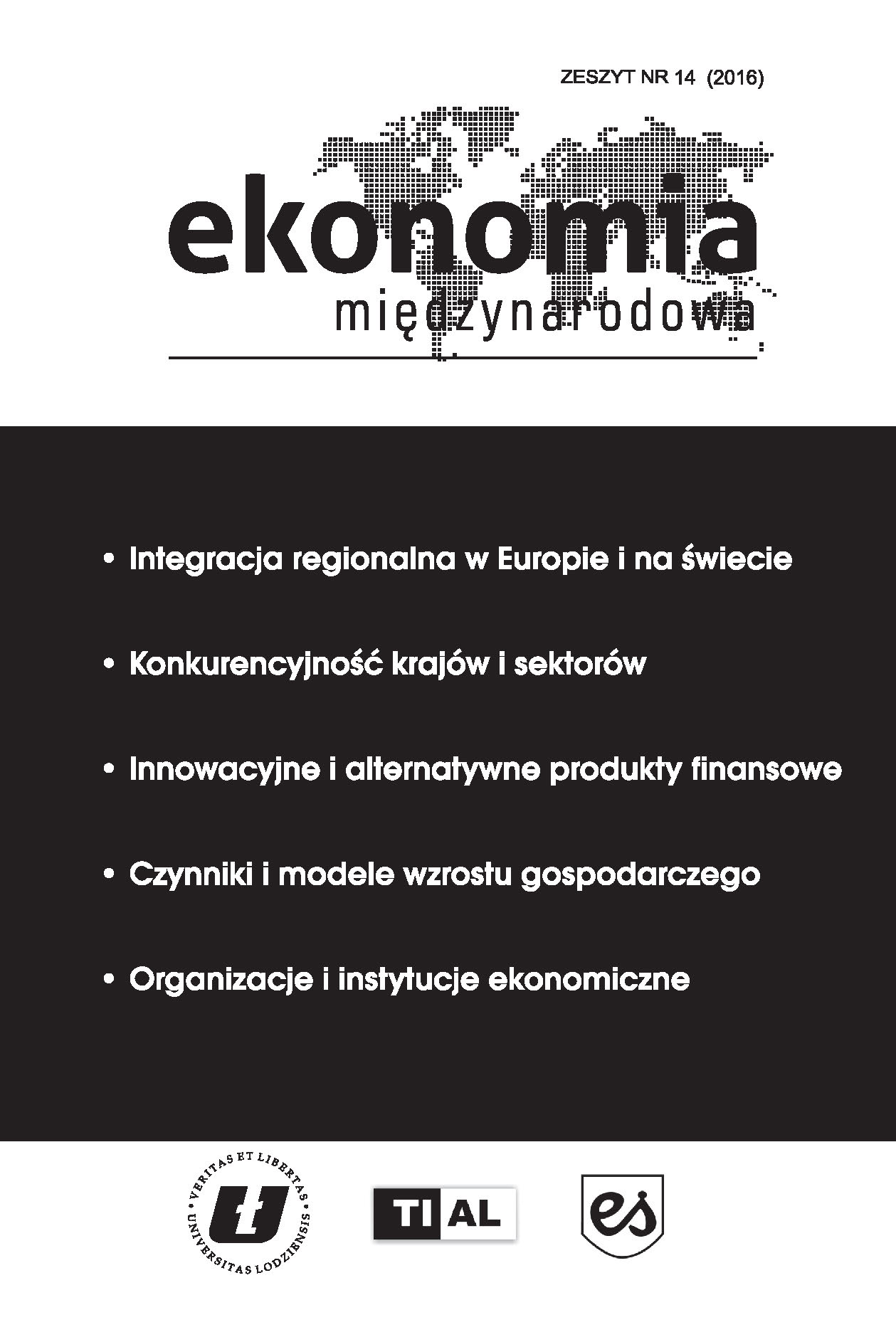Impact of Innovative Financial Products on Financial Systems: Exchange Traded Products and the Polish Financial System
DOI:
https://doi.org/10.18778/2082-4440.14.02Keywords:
Exchange Traded Funds, financial innovations, financial stability, mutual fundsAbstract
Exchange Traded Products (ETPs) are one of the most recent and most rapidly developing financial products. As their assets grow they have an increasing impact on financial systems in many countries, including the USA, UK or Japan. Development of ETPs is linked with many opportunities and threats for the local financial systems. Their correct assessment is becoming more difficult due to the growing complexity of the available products, thus posing problems not only for the participants of the financial markets (including buyers and sellers of ETPs as well as intermediaries) but also for the supervising authorities. The main ETP development trends (e.g. size of the global assets under management) are outlined in this article. Structural changes are discussed in the context of their impact on both local and global financial systems. One of the key topics is the consequences of the changing landscape of the most popular type of ETP – Exchange Traded Funds (ETFs). Simple and safe physical ETFs are being replaced by complicated synthetic ETFs, significantly increasing possible risks for the holders of such products, for other entities involved in their creation and distribution, and, consequently, for the whole financial system. The last part of the article is devoted to the Polish perspective on this topic. It may be argued that in Poland the role of ETPs (even ETFs) is still marginal. ETPs can influence the Polish financial system, however, through a number of links between Polish and foreign financial institutions and markets. As a result, fast transmission of the future shocks caused by such products is increasingly more probable.
References
Agapova A. (2011), Conventional mutual index funds versus exchange-traded funds, Journal of Financial Markets, 14(2).
Google Scholar
DOI: https://doi.org/10.1016/j.finmar.2010.10.005
Aggarwal R., Schofield L. (2014), The Growth of Global ETFs and Regulatory Challenges [in:] Kose J., Makhija A.K., Ferris S.P. (eds.), Advances in Financial Economics, Emerald Group Publishing Limited.
Google Scholar
DOI: https://doi.org/10.1108/S1569-3732(2013)0000016003
Black Rock (2012), ETP Landscape – Global Handbook 2012.
Google Scholar
Chodnicka P., Jaworski P. (2012), Śledząc parkiet – analiza jakości odwzorowania indeksu WIG20 przez pierwszy na polskim rynku fundusz Exchange Traded Fund, Problemy Zarządzania, 39(4).
Google Scholar
DOI: https://doi.org/10.7172/1644-9584.39.13
Deutsche Bank (2014), ETF Annual Review & Outlook 2014.
Google Scholar
Deutsche Bank (2015), ETF Annual Review & Outlook 2015.
Google Scholar
Deville L. (2008), Exchange Traded Funds: History, Trading and Research [in:] Doumpos M., Pardalos P., Zopounidis C. (eds.), Handbook of Financial Engineering, Springer US.
Google Scholar
DOI: https://doi.org/10.1007/978-0-387-76682-9_4
Diaz-Rainey I., Ibikunle G. (2012), A Taxonomy of the ‘Dark Side’ of Financial Innovation: The Cases of High Frequency Trading and Exchange Traded Funds, International Journal of Entrepreneurship and Innovation Management, 16(1).
Google Scholar
DOI: https://doi.org/10.1504/IJEIM.2012.050443
Dickson J., Mance L., Rowley Jr. J. (2013), Understanding synthetic ETFs. Vanguard Research, June 2013.
Google Scholar
ETFGI (2014), ETFs Revisited.
Google Scholar
ETFGI (2015), ETFGI Monthly Newsletter May 2015.
Google Scholar
European Securities and Markets Authority (2012), Guidelines for competent authorities and UCITS management companies: Guidelines on ETFs and other UCITS issues.
Google Scholar
Financial Stability Board (2011), Potential financial stability issues arising from recent trends in Exchange-Traded Funds (ETFs).
Google Scholar
Foucher I., Gray K. (2014), Exchange-Traded Funds: Evolution of Benefits, Vulnerabilities and Risks, Bank of Canada Financial System Review, December 2014.
Google Scholar
Hurlin C., Iseli G., Perignon C., Yeung S. (2014), The Collateral Risk of ETFs, Université de Genève Working Paper Series.
Google Scholar
DOI: https://doi.org/10.2139/ssrn.2462747
International Organization of Securities Commissions (2013), Principles for the Regulation of Exchange Traded Funds.
Google Scholar
International Monetary Fund (2011), Global Financial Stability Report: Durable Financial Stability. Getting There from Here, World Economic and Financial Surveys.
Google Scholar
Investment Company Institute (2015), Investment Company Fact Book 2015, Washington, DC.
Google Scholar
Kosev M., Williams T. (2011), Exchange-traded Funds, Reserve Bank of Australia Bulletin, March Quarter.
Google Scholar
Lechman E., Marszk A. (2015), ICT technologies and financial innovations: the case of Exchange Traded Funds in Brazil, Japan, Mexico, South Korea and the United States, Technological Forecasting and Social Change, 99.
Google Scholar
DOI: https://doi.org/10.1016/j.techfore.2015.01.006
Marszk A. (2014), Exchange Traded Funds (ETFs) on emerging markets [in:] Buszko M., Huterska A., Piotrowski D. (eds.), Perspective: Challenges of modern finance and banking, Nicolaus Copernicus University in Toruń Publishing, Toruń.
Google Scholar
Mitrenga D. (2014), Oszacowanie błędu naśladowania przez dostępny na polskim rynku fundusz ETF wraz z określeniem jego przyczyn, Studia Ekonomiczne Uniwersytetu Ekonomicznego w Katowicach, 177.
Google Scholar
Miziołek T. (2013), Pasywne zarządzanie portfelem inwestycyjnym – indeksowe fundusze inwestycyjne i fundusze ETF, Wydawnictwo Uniwersytetu Łódzkiego, Łódź.
Google Scholar
Naumenko K., Chystiakova O. (2015), An Empirical Study on the Differences between Synthetic and Physical ETFs, International Journal of Economics and Finance, 7(3).
Google Scholar
DOI: https://doi.org/10.5539/ijef.v7n3p24
Nawrot W. (2007), Exchange-Traded Funds: Nowe produkty na rynku funduszy inwestycyjnych, Cedewu Wydawnictwa Fachowe, Warszawa.
Google Scholar
Ramaswamy S. (2011), Market structures and systematic risks of exchangetraded funds, BIS Working Papers No. 343, Basel.
Google Scholar
Rubino J. (2011), Emerging Threat Funds?, CFA Magazine, 22(5).
Google Scholar
DOI: https://doi.org/10.2469/cfm.v22.n5.7
Warsaw Stock Exchange (2015), WSE Fact Book 2014.
Google Scholar
World Federation of Exchanges (2015), WFE Database.
Google Scholar
Downloads
Published
How to Cite
Issue
Section
License

This work is licensed under a Creative Commons Attribution-NonCommercial-NoDerivatives 4.0 International License.









